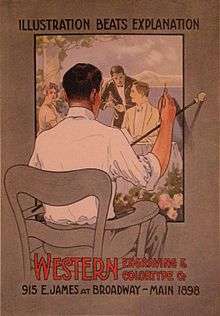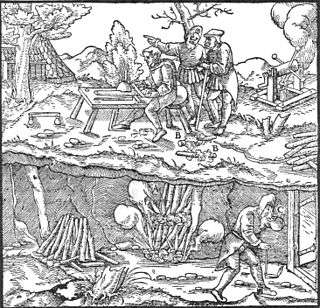Illustration

An illustration is a decoration, interpretation or visual explanation of a text, concept or process,[1] designed for integration in published media, such as posters, flyers, magazines, books, teaching materials, animations, video games and films.
The origin of the word “illustration” is late Middle English (in the sense ‘illumination; spiritual or intellectual enlightenment’): via Old French from Latin illustratio(n- ), from the verb illustrate.[2]
Contemporary illustration


Contemporary illustration uses a wide range of styles and techniques, including drawing, painting, printmaking, collage, montage, digital design, multimedia, 3D modelling. Most illustrators work on a freelance basis.
Depending on the purpose, illustration may be expressive, stylised, realistic or highly technical.
Specialist areas[3] include:
- Archaeological illustration
- Book illustration
- Botanical illustration
- Concept art
- Fashion illustration
- Information graphics
- Technical illustration
- Medical illustration
- Narrative illustration
- Picture books
- Scientific illustration
- Technical drawing
Technical and scientific illustration


Technical and scientific illustration communicates information of a technical or scientific nature. This may include exploded views, cutaways, fly-throughs, reconstructions, instructional images, component designs, diagrams. The aim is "to generate expressive images that effectively convey certain information via the visual channel to the human observer"[4]
Technical and scientific illustration is generally designed to describe or explain subjects to a nontechnical audience, so must provide "an overall impression of what an object is or does, to enhance the viewer's interest and understanding".[5]
In contemporary illustration practice, 2D and 3D software is often used to create accurate representations that can be updated easily, and reused in a variety of contexts.
Illustration as fine art

In the art world, illustration has at times been considered of less importance than graphic design and fine art.
Today, however, due in part to the growth of graphic novel and video game industries, as well as increased use of illustration in magazines and other publications, illustration is now becoming a valued art form, capable of engaging a global market.
Original illustration art has been known to attract high prices at auction. The US artist Norman Rockwell's painting "Breaking Home Ties" sold in a 2006 Sotheby's auction for USD15.4 million.[6] Many other illustration genres are equally valued, with pinup artists such as Gil Elvgren and Alberto Vargas, for example, also attracting high prices.
History


Historically, the art of illustration is closely linked to the industrial processes of printing and publishing.
Early history
The illustrations of medieval codices were known as illuminations, and were individually hand drawn and painted. With the invention of the printing press during the 15th century, books became more widely distributed, often illustrated with woodcuts.
1600s Japan saw the origination of Ukiyo-e, an influential illustration style characterised by expressive line, vivid colour and subtle tones, resulting from the ink-brushed wood block printing technique. Subjects included traditional folk tales, popular figures and every day life. Hokusai’s The Great Wave of Kanazawa is a famous image of the time.
During the 16th and 17th centuries in Europe, the main reproduction processes for illustration were engraving and etching. In 18th Century England, a notable illustrator was William Blake (1757–827), who used relief etching. By the early 19th century, the introduction of lithography substantially improved reproduction quality.
19th Century
In Europe, notable figures of the early 19th Century were John Leech, George Cruikshank, Dickens illustrator Hablot Knight Browne, and, in France, Honoré Daumier. All contributed to both satirical and “serious” publications. At this time, there was a great demand for caricature drawings encapsulating social mores, types and classes.
The British humorous magazine Punch (1841–2002) built on the success of Cruikshank's Comic Almanac (1827–1840) and employed many well-regarded illustrators, including Sir John Tenniel, the Dalziel Brothers, and Georges du Maurier. Although all fine art trained, their reputations were gained primarily as illustrators.
In common with similar magazines such as the Parisian Le Voleur, Punch realised good illustration sold as well as good text. With publication continuing into the 21st Century, Punch chronicles a gradual shift in popular illustration, from reliance on caricature to sophisticated topical observation.
The “Golden Age”
From the early 1800s newspapers, mass market magazines, and illustrated books had become the dominant consumer media in Europe and the New World. By the 19th Century, improvements in printing technology freed illustrators to experiment with color and rendering techniques.
In America, this led to a "golden age of illustration" from before the 1880s until the early 20th Century. A small group of illustrators became highly successful, with the imagery they created considered a portrait of American aspirations of the time.[8]
See also
- Association of Illustrators
- Association of Medical Illustrators
- Communication design
- Graphic design
- Illustrators
- Institute of Medical Illustrators
- Posters
- Society of Illustrators
References
- ↑ cf. the freely available international Database of Scientific Illustrators 1450-1950 with 20 search fields and nearly 7000 entries of illustrators in science, medicine & technology active prior to 1950
- ↑ "Oxford Dictionary".
- ↑ "Prospects.ac.uk".
- ↑ Ivan Viola and Meister E. Gröller (2005). "Smart Visibility in Visualization". In: Computational Aesthetics in Graphics, Visualization and Imaging. L. Neumann et al. (Ed.)
- ↑ Industriegrafik.com website, Last modified: June 15, 2002. Accessed february 15, 2009.
- ↑ Norman Rockwell's Rising Value Prices Out His Museum Zac Bissonnette, AOL Daily Finance, 2-22-10
- ↑ "American Turk's cap Lily". Victoria and Albert Museum. Retrieved 2007-12-12.
- ↑ The R. Atkinson Fox Society: What Was the Golden Age of Illustration?
External links
![]() Media related to Illustrations at Wikimedia Commons
Media related to Illustrations at Wikimedia Commons